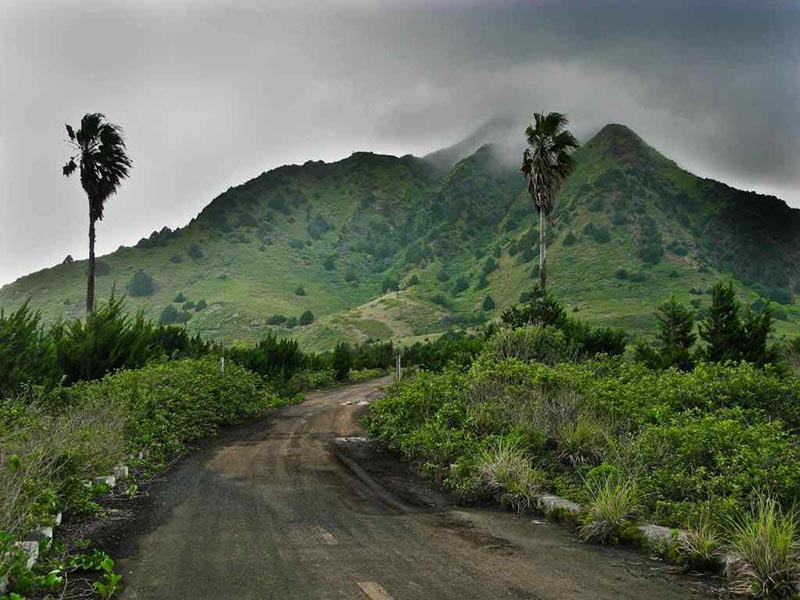Conservation > Explore the Island > Green Mountain

Green Mountain was designated as a National Park in 2005. The peak of Green mountain reaches 859m and is the highest point on the island.
Early visitors to Ascension Island at the beginning of the 19th century, described it as exceptionally barren, with very few plants - including the mountain that we know now as Green Mountain. Only a handful of species - mostly ferns, mosses and some grasses, most of them endemic to Ascension - were found on the higher slopes of Green Mountain. It was a far cry from the lush vegetation that now spans across the mountain. The mountain we see today is the result of a huge venture into ecological terraforming.
Charles Darwin visited Ascension in 1836 and admired the 'active industry' on the mountain, where the Royal marines had established a garden to supply vegetables and fruit for the garrison, but lamented that the Island was "destitute of trees". It was Joseph Hooker, close friend of Charles Darwin and later Director of the Royal Botanical Gardens, Kew, who proposed a plan to increase vegetation on the mountain, following a visit in 1843.
Hooker's strategy involved planting trees to increase rainfall, introducing vegetation on steep slopes to prevent soil erosion and introducing a wide variety of crops. There was a mass planting of organised forests, shrublands and pasture on the island, introducing over 220 exotic plant species from diverse parts of the world. Records show early naval ships carrying seed and seedlings from botanical gardens in Europe, South Africa and Argentina. Kew Gardens in the UK sent over 330 plant specimens to Ascension and continue to be closely involved with the conservation work on Green Mountain today. Ultimately only the fittest of the introduced species survived, leaving us today with an eclectic mix of plants from all over the world. Prior to human settlement, the native ecosystems on Ascension were at a relatively early stage of development and while Green Mountain is an unmistakable success at creating a green oasis, it can also be argued that it was a man-made biological invasion that has degraded a previously pristine island environment.
Most of Ascension's native and endemic plants are now being severely out-competed by those that were introduced; however, the Conservation and Fisheries Directorate is working to find a balance between native and endemic flora, and those that were introduced. Some introduced species can actually be beneficial for native species, such as bamboo, which provides habitat for endemic ferns to grow on.
There is a wide variety of trails that are maintained by the Reserve Warden team. These offer fantastic views of the island and mountain itself. As elevation increases, so does rainfall, and this provides dramatically different scenery. Trails around the Residency, such as Convalescent's, will meander through eucalyptus trees, while climbing to the peak of Green Mountain will take walkers into a dense, misty bamboo forest. The Conservation and Fisheries Directorate encourage visitors to the park to explore the many paths and historic sites within it, whilst also reminding visitors to respect the park in order that it may be enjoyed by all island residents and visitors.
You can find the following flora and fauna at the Green Mountain National Park:
Type: Endemic Plant | Status: Critically Endangered | Nativeness: Endemic
A tiny fern with small parsley-like fronds that grows on moderately dry to wet banks and outcrops on the exposed south-facing slopes of Green Mountain.
Type: Endemic Plant | Status: Vulnerable | Nativeness: Endemic
A small, creeping fern generally found in crevices on damp to moderately dry cinder banks and rock faces around the middle elevations of Green Mountain.
Type: Endemic Plant | Status: Critically Endangered | Nativeness: Endemic
A small to medium-sized fern forming shuttlecock shaped tufts, generally found growing in rock crevices or on cliffs in sheltered valleys around the foot slopes of Green Mountain.
Type: Endemic Plant | Status: Critically Endangered | Nativeness: Endemic
A small, perennial, tuft forming grass found on damp, wind-exposed banks and outcrops around on the upper slopes of Green Mountain.
Type: Invertebrate | Status: Not Evaluated | Nativeness: Native
A large, terrestrial crustacean that occurs in a wide range of colour morphs from pale yellow-orange to deep purple.
Type: Habitat | Status: Not Evaluated | Nativeness: Endemic
Ascension Island’s cloud forest zone, or mist region, is confined to the summit slopes of Green Mountain, where frequent immersion in cloud banks creates continuously damp conditions.
Type: Endemic Plant | Status: Critically Endangered | Nativeness: Endemic
This is a tiny fern with linear, narrow laminae (fronds) which grows as a lithophyte on damp, wind-exposed banks and rocks.
Type: Endemic Plant | Status: Critically Endangered | Nativeness: Endemic
This imposing fern is the largest of Ascension Island’s endemic plant species, with dark green, twice pinnate fronds up to 1m in length.
Type: Seabird | Status: Least Concern | Nativeness: Native
Small and white, these inquisitive terns are known locally on Ascension as Fairy terns. These delightful birds will regularly approach hikers and momentarily hover in the air above. They are the only species of tree-nesting seabird on Ascension.
[wp_rss_retriever url="https://rss.app/feeds/MNrgI5Ybn5Se8Pg6.xml" items="1" excerpt="0" read_more="true" title="true" source="false" credits="false" new_window="true" thumbnail="false" date="true" ajax="false" cache="3600"]
